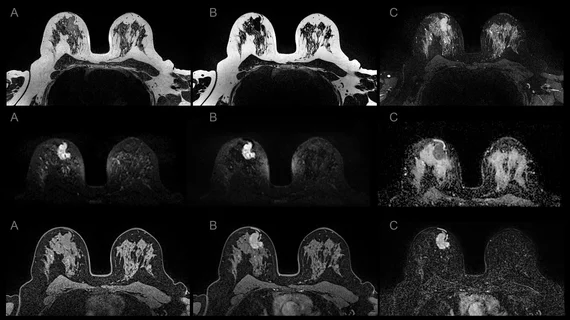Abbreviated breast MRI protocols not as cost-effective as promised, new study shows
Abbreviated breast MRI scans are becoming increasingly popular due to their ability to reduce scan times without sacrificing sensitivity, but experts recently cautioned that the exam does not come without challenges to consider.
Researchers recently discussed these challenges in the European Journal of Radiology after completing a study of their own that investigated a myriad of potential snags that stand in between vision of increasing patient throughput and the reality of actually achieving it.
“Evidence on the actual impact of scan time reduction on patient throughput is [however] scarce and a related retrospective study performed on this matter revealed a discrepancy between expected and actual increase in patient flow, most likely owed to non-scan related activities,” corresponding author P.A. Baltzer, from the Department of Biomedical Imaging and Image-guided Therapy, Division of General and Pediatric Radiology in Vienna, Austria, and colleagues explained.
The experts sought to assess how factors like table switch time (TST), planning time (PT), and other occurrences that take place in between exams (I.e., cleaning, dressing, obtaining IV access, etc.) impact patient throughput for abbreviated breast MRI exams, and whether the exam setting (in-patient vs out-patient) affected patient flow.
They included a total of 143 abbreviated breast MRIs from 4 different study sites (1 hospital, 3 radiology centers). Full diagnostic protocols were included alongside the abbreviated exams for comparison.
The experts found that although abbreviated protocols increased the amount of possible scans per hour from 4.7 to 18.8, non-scanning time rose from 50% to 74%. This could be attributed to increased table switch time (46%) and planning time (28), the researchers suggested.
“Our analysis shows that reduction of scan time does not necessarily improve throughput per MRI unit in the desired extent, since a significant amount of total exam time consists of planning the exam and switching patients.”
Of note, there were no statistically significant differences in total exam times between settings.
These findings challenge the notion that abbreviated breast MRI protocols increase patient throughput, and without adjusting workflow-related parameters cost-effectiveness cannot be achieved, the experts said.
The study abstract can be viewed in the European Journal of Radiology.

